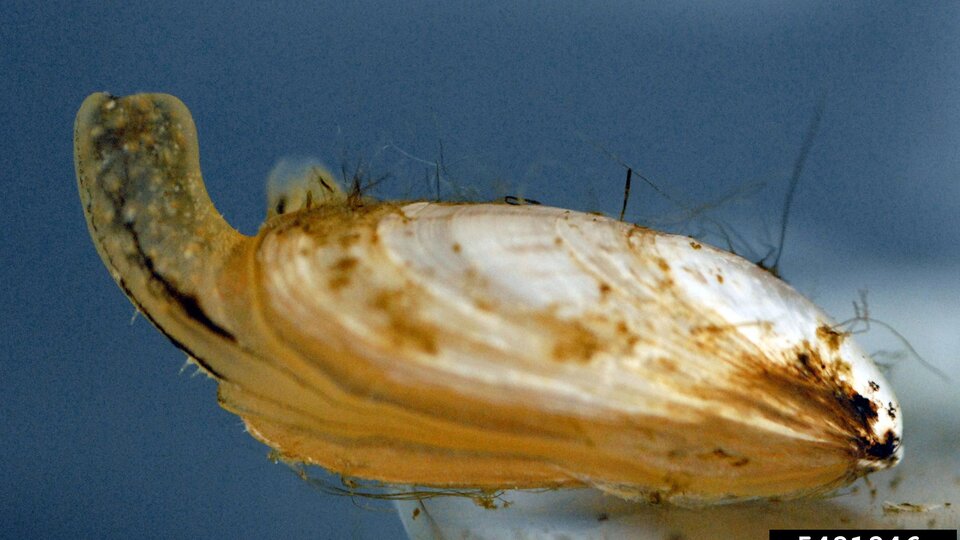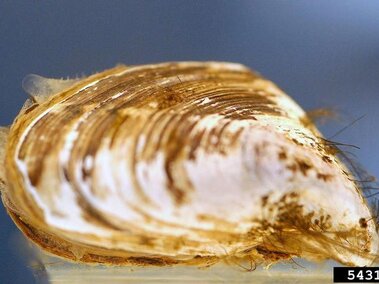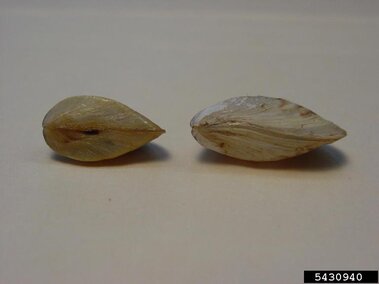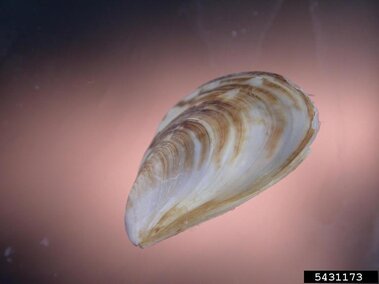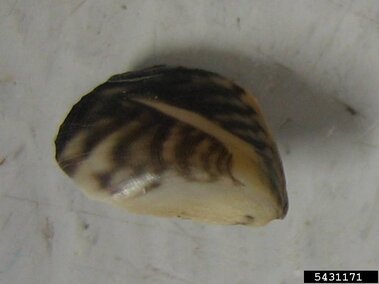Credit: Mike Quigley, NOAA, Bugwood.org
General Information
Species Name: Dreissena rostriformis bugensis
Family: Dreissenidae (False Mussel)
Life Span: 3-9 years
Life Cycle: Quagga mussels hatch then go through planktonic larval stages for up to 4 weeks. Larvae are usually moved by water flow. Once larvae are large enough they develop into their juvenile stage. At this point they settle to the bottom and search for a substrate to attach to by a cluster of threads called a byssus. A single reproductively mature female may produce as many as a million eggs per breeding season.
Origin: Europe
Injurious: Yes. Currently under the Lacey Act, quagga mussels are listed as injurious wildlife by the U.S. Fish and Wildlife Service, which prohibits the importation into or transportation between the continental United States, the District of Columbia, Hawaii, the Commonwealth of Puerto Rico or any territory or possession of the United States of live quagga mussels, gametes, viable eggs and hybrids.
Category 1: Potential Aquatic Invasive Species
Why Are They Invasive?
Quagga mussels are extreme water/food filters. They eat up the food source of fish and can drastically change an aquatic ecosystem. They also take in many pollutants (at levels higher than the surrounding area), which can harm wildlife that eats the mussel. Some researchers believe that Lake Erie's dead zone may be caused by their non-stop feeding, their ability to live in deep water (up to 130 meters in the Great Lakes), and the excretion of phosphorous with their waste. Like zebra mussels, the quagga mussels also clog water intake pipes and underwater screens. This plugs up pumps at power and water treatment plants, costing the government and businesses millions yearly to fix. In addition, quagga mussels build up in places that may hinder summer fun - piers, break walls, buoys, boats and beaches.
What Do They Look Like?
Quagga mussels, like zebra mussels, have black stripes on tan bodies. Unlike the zebra mussel, the quagga mussel shell has a rounded angle. The quagga is no bigger than an adult's thumbnail. It is light tan to almost white, with narrow stripes or blotchy lines. The shell is fan-shaped with pointed edges at either side. The ventral (bottom side where the two shells attach) side of the quagga mussel is convex, making it topple over when you try to stand it up on a flat surface. The zebra mussel will remain upright when placed in this position.
Photos
Where Do They Live?
Quagga mussels inhabit freshwater rivers, lakes, and reservoirs. In North American populations, they are not known to tolerate salinities greater than 5 ppt. Water temperatures of 28°C begin to cause significant mortality, and 32-35°C are considered lethal for Dreissena species. The depth at which the mussels live varies depending on water temperature. They are not generally found in lakes near shore in shallow water due to wave action. The quagga mussel can inhabit both hard and soft substrates, including sand and mud, down to depths of 130 m and possibly deeper.
How Do They Spread?
Native to the Black Sea region of Eurasia, they arrived in the Great Lakes via ballast water in the larval (veliger) stage and have spread throughout North America. They latch on to boats and can be easily spread between water bodies.
How Do I Control Them?
Management of invasive aquatic animals involving either mechanical removal or application of chemicals to public waters requires a permit. Contact the Contact the Nebraska Game and Parks Commission for more information.
CLEAN your watercraft, trailer, angling gear and other equipment. Remove all aquatic vegetation and animal species from your equipment.
DRAIN your watercraft at the ramp by removing the boat plug and draining all live wells and ballast tanks.
DRY your watercraft, trailer and other equipment for at least 7 days before visiting another waterbody.
DON'T DUMP BAIT. Dispose of bait by emptying bait buckets on dry land, away from waterbodies or in a trash receptacle. Moving a live organism from one waterbody to another is illegal, even if you are planning to use the organism as bait.
DON'T LET IT LOOSE. Do not release or transport exotic or non-native fish species to new ecosystems. It is unlawful to release any aquatic species into a waterbody other than the one from which it was harvested. Doing so can promote the spread of AIS.
What Should I Do If I See Them in Nebraska?
If you see quagga mussels in Nebraska, you should report them to the Nebraska Game and Parks Commission's Aquatic Invasive Species (AIS) Program using their AIS Report Form. For guidance on what information to include in your report, check out our reporting tips.
References and More Information
Center for Invasive Species and Ecosystem Health
University of Montana Flathead Lake Biological Station
National Invasive Species Information Center
Nebraska Game and Parks Commission
NOAA National Centers for Environmental Information
Smithsonian Environmental Research Center
Summary of Species Currently Listed as Injurious Wildlife under (18 U.S.C. 42) Lacey Act
Texas Invasive Species Institute
